
The Numbers Game: Making Hospital Data User-Friendly
William Feaster, M.D., Chief Health Information Officer, Choc Children’s

 William Feaster, M.D., Chief Health Information Officer, Choc Children’s
William Feaster, M.D., Chief Health Information Officer, Choc Children’sRecently, our analytics team was approached by a nursing administrator with a staffing dilemma that, given my many years working in pediatric health systems, I knew wasn’t unique to CHOC Children’s.
Following standard protocol, nursing administration was being held accountable for staffing and budgets based on the midnight daily census, a report that provides an official count of the total number of patients present in the hospital at one point in time. Unfortunately, that single point in time ― midnight― was the lowest number of patients in the hospital throughout any 24-hour period. While well-intended, this administrator was routinely over budget for needing to adequately staff for a much larger number of patients in the hospital during daytime hours.
What could be perceived as oversight by the nursing administrator is actually a more complex issue. The reality is that the in patient census is notoriously volatile in most hospitals.
Spikes in the census will cause huge difficulties in capacity management, staffing and patient placement. Still, accurately predicting patient census is critical for managing a unit, since staffing levels can be linked to labor costs, patient safety, quality of care, length of stay, readmissions, and staff turnover. Due to its impact on a hospital’s performance, it’s imperative the correct decisions are made.
THE POWER OF DASHBOARDS
The default mechanism would be to rely on antiquated staff¬ing strategies, designs and operations that are paper-based and driven by opinion and tradition. The more evidence-based approach would be to utilize the massive quantities of data collected in the hospital on a daily basis and present it in a manner that is easy for nursing administrators to understand and digest. In this case, providing the administrator with a digital dashboard allowed her to have a bird’s eye view of the situation. She, in turn, could now have access to real-time data collected from various sources and use this to base her decisions and ultimately, improve efficiency, quality and patient safety.
For example, the dashboard can provide the actual hourly census throughout the day, by unit, by bed, and by patient. It also includes patient information and acuity, discharge information, as well as nursing staffing over the same period. As a result, she can rethink staffing practices, policies and procedures, and create new models based on this dashboard, and easily justify proper budgeting for needed staff.
TRANSLATING NEW INSIGHTS
At CHOC, we rely on over 20 dashboards to monitor everything from employee turnover to surgical block utilization. A well-designed dashboard can raise awareness of hospital or practitioner performance, including identifying high levels of performance as well as areas for improvement.
We, as all hospitals now, are under growing pressure to better manage the quality and efficiency of care, address the vast array of new payment approaches and ensure the health of a large and diverse population. There is no way to effectively do this without relying on the mounds of data we collect on a daily basis.
Yet, just as important as the collection of the data is the ability to transform it using visualization tools that create images so that the data is presented in a way that is easy to understand and interpret. The human brain processes visual information better than text, so using charts, graphs and other design elements are more effective. Also of key importance, these dashboards provide end users with the ability to explore their data from high levels of summarization to high levels of detail, gaining insight not previously available in a static report.
Ultimately, the insights from the data have the potential to touch multiple aspects of healthcare: safety and effectiveness of different treatments, outcomes achieved with different delivery models, and predictive models for diagnosing, treating and delivering care. In addition, this data may enhance our understanding of patient behavior, which will help in how we treat diseases and conditions.
Read Also















